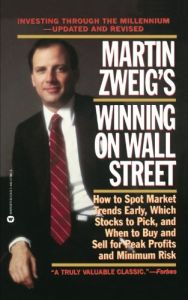Join getAbstract to access the summary!

Join getAbstract to access the summary!
Martin Zweig
Winning on Wall Street
How to spot Market Trends Early, Which Stocks to Pick, and When to Buy and Sell for Peak Profits and Minimum Risk
Warner Books, 1997
What's inside?
Learn from one of the smartest and most successful stock pickers ever to walk down Wall Street.
Recommendation
Martin Zweig is one of the smartest and most successful stock pickers ever to walk down Wall Street, and he’s not ashamed to admit it. This book tells you more than you ever knew you wanted to know about him personally before getting down to the brass tacks of his investment methodology, but then he delivers one of the best guides to investing ever written. You don’t even have to trade stock actively to benefit from his lucid explanation of how the market works. getAbstract.com recommends this book for anyone with savings or investments, and especially for active stock investors.
Summary
About the Author
Martin Zweig is chairman of The Zweig Fund and The Zweig Total Return Fund, and publisher of the Zweig Forecast.



















Comment on this summary